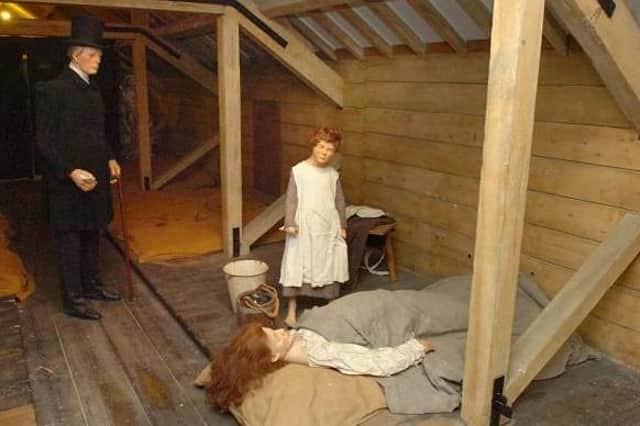Derry’s haunted spots detailed - hauntings, vampire and lough monster at paranormal zones


The study, by campervan rental platform PaulCamper, was compiled from the Paranormal Database - a record of ghostly goings on in Ireland and Britain.
It found that there were twelve paranormal hotspots across Co. Derry.
Advertisement
Hide AdAdvertisement
Hide AdThree haunting manifestations in the city proper were identified. These were at the former Waterside Workhouse, the Foyle Arts Centre and at City of Derry Airport.
Many readers will be familiar with the tales of reports of uncanny happenings at each of these locations. According to local lore the entire workhouse site on the Glendermott Road is haunted.
One supernatural story connected with it is that a former nurse, who had taken ill, at one time woke up during her treatment to find a woman, dressed in white, placing an extra blanket on her bed, before disappearing through the wall of the room.
Advertisement
Hide AdAdvertisement
Hide AdAnother awful yarn is that a matron who accidently starved three children to death in a punishment cupboard still haunts the area.
The Foyle Arts Centre, nestled down behind Magee College off Lawrence Hill, is famously haunted by the ‘lady with the lamp.’ According to some she can be seen walking the upper floors of the building that was once home to Foyle College carrying a lantern in her ephemeral hands.
Workers at City of Derry Airport and in the general area from Eglinton to Maydown, meanwhile, have in the past reported seeing spectral figures dressed in airmen’s uniforms dating from era of the Second World War on manoeuvres in the general vicinity.
Advertisement
Hide AdAdvertisement
Hide AdThere are two reported hauntings down the road in Limavady - the most famous perhaps that of the former Roe Valley Hospital which is listed as being haunted by an ‘unknown ghost type.’
The database records how in mid-2009 ‘while photographing the building at night, a security guard caught a strange “figure” on camera. Paranormal Society Ireland called the picture authentic.’
Another purported haunting is said to be in the locality of a former coach house on the Limavady mountain that is no longer standing.
Advertisement
Hide AdAdvertisement
Hide AdThe Ram’s Horn, it is said, was once a popular meeting place for criminals and robbers and ‘when the building fell into ruin, many believed that the criminals’ ghosts still lurked in the area’.
Two of the twelve listings relate to a very ancient evil, that of Abhartach, a chieftain from the Glenullin district who is believed to live on as a blood-drinking representative of the neamh-mairbh, or the walking dead. Both Glenullin and the Slaghtaverty Dolmen, known locally as the Giant’s Grave, where his restless soul is supposed lurk are listed in the database under the heading vampire.
“In a battle for the throne, the warrior Cathrain killed his rival Abhartach. Abhartach, however, returned from the grave two days later and preyed on the locals. Cathrain once again killed the undead fiend, but two days later, Abhartach came back and continued his attacks.
“Cathrain discussed the problem with druids, who told him to stab his adversary through the heart with a weapon made of yew. This he did, and Abhartach never returned,” the database states.
Advertisement
Hide AdAdvertisement
Hide AdThere are other versions, as we will see. Some have argued the legend of Abhartach provided inspiration for Bram Stoker as the story - though likely around for millennia - was first popularised by Patrick Weston Joyce in his ‘The Origin and History of Irish Names of Places’ (1870), published not long before ‘Dracula’ in 1897.
In his Ordnance Survey letters from Derry in 1834 John O’Donovan, who visited Glenullin referred to Abhartach as ‘great musician’ who was a fairy of the Tuatha Dé Danann, the mythological tribe of the goddess Danu, and was mentioned alongside Manannán mac Lir in the 15th century Book of Lecan.
O’Donovan, who incidentally referred to the people of Glenullin, as ‘remarkable for their intelligence’ got a different account from them of the fate of Abhartach which he sent to Lieutenant Thomas A. Larcom from Dungiven on August 4, 1834. He describes him as a ‘remarkable enchanter and great enemy to Finn MacCool.’
Advertisement
Hide AdAdvertisement
Hide AdWrote O’Donovan: “He was vulnerable only in one spot of his body. Finn, by the prophecy deduced from his thumb (already well celebrated), discovering where this spot was situated, aimed him through with his spear and killed him. He then buried him with his head downwards lest he might effect a resurrection.”
Evidently this tactic didn’t work and the Abhartach legend lives on. It provided the subject matter for Chris Baugh’s well-received 2021 horror feature ‘The Boys from the County Hell.’
A curious listing relates to a mysterious creature from the depths reportedly sited at Ballyronan in the loughshore area of south Derry in 1986. It’s put down as an instance of cryptozoology but you could call it the ‘Lough Neagh monster.’ Famous though the lough is for its eels, this was of a different order.
“Two people in a two man kayak quickly headed towards the shore after spotting a long black creature under the water with a body the thickness of two human legs. A local legend says that Lough Neagh is also home to fairies, who can be heard laughing, and that the lough was created when someone forgot that they had left the cover off a magic well,” the database states.